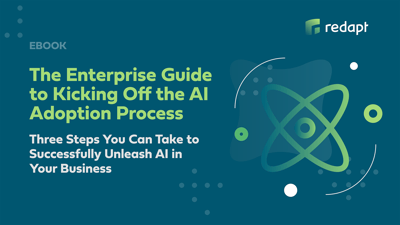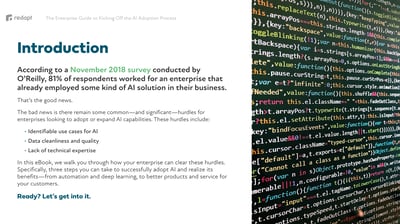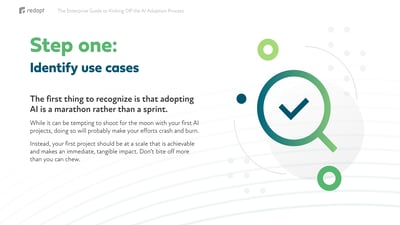As enterprises dive into AI adoption, it is critical that they understand industry trends. The recent Forbes article, Top Artificial Intelligence (AI) Predictions for 2020 from IDC and Forrester dives deep into the trends we can expect in the coming year.
Here’s our take on the trends from the article, as well as a few others we’ve identified from working with our clients:
 1. Automation gets bigger and better
1. Automation gets bigger and better
According to the article, IDC predicts that within two years “75% of enterprises will embed intelligent automation into technology and process development, using AI-based software to discover operational and experiential insights to guide innovation.”
Download Now: The Enterprise Guide to Kicking Off the AI Adoption Process
We agree. Over the last few years alone, new algorithms and tools have greatly enhanced automation for industries, and those tools are only going to get more robust.
 2. The divide between AI haves and have-nots is only going to increase
2. The divide between AI haves and have-nots is only going to increase
From the article: “AI adoption is not consistent across all companies and we are seeing a new digital divide, a divide between the AI haves and the AI have-nots, those with or without the required highly skilled engineers.”
The way we see it, while it’s likely there will be a bit of a divide, the tools and resources available will only get less expensive, allowing more companies to utilize AI and machine learning (ML) in order to stay competitive.
 3. What constitutes the “workforce” is changing
3. What constitutes the “workforce” is changing
IDC predicts that IT organizations will manage and support a growing workforce of AI-enabled RPA bots as intelligent automation scales across enterprises.
But while chatbots will increasingly assist with a variety of tasks, conversation AI will still only power fewer than one in five successful customer service interactions by the end of 2020.
Here IDC is onto something. Ultimately, the way enterprises will be successful is tied into data scientists spending their time solving problems rather than focusing on IT and ML infrastructure.
 4. New ways for managing ML workflows will be needed
4. New ways for managing ML workflows will be needed
This is a key issue, since a number of enterprises struggle to manage ML workflows. The questions are:
- How do you create CI/CD for machine learning?
- How do you maintain versions in data?
- How do you keep a full pipeline?
While there are current answers to these questions, in order for AI to continue to expand in usage, the management solutions need to continue to improve.
For further insight on AI adoption, download our free eBook, The Enterprise Guide to Kicking Off the AI Adoption Process.
Categories
- Cloud Migration and Adoption
- Enterprise IT and Infrastructure
- Artificial Intelligence and Machine Learning
- Data Management and Analytics
- DevOps and Automation
- Cybersecurity and Compliance
- Application Modernization and Optimization
- Featured
- Managed Services & Cloud Cost Optimization
- News
- Workplace Modernization
- Tech We Like
- AWS
- Social Good News
- Cost Optimization
- Hybrid Cloud Strategy
- NVIDIA
- Application Development
- GPU








